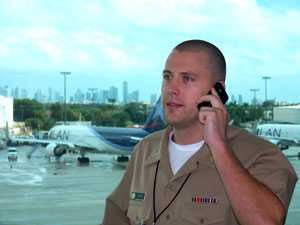From One Baby with Measles to Exposing 270 International Students
Measles can easily become a stowaway on a flight to the United States.
This highly contagious and serious disease continues to be common throughout the world, including Europe. Because of decades of measles vaccination in the United States, most cases of measles that occur in the United States are linked to cases imported from another country by U.S. residents and visitors. Measles outbreaks in Europe during 2010–2011 caused an increase in the number of measles cases imported to the United States. In 2011, the United States had more measles cases than any other year since 1996.
Vaccination is the best possible prevention.
This measles exposure started in July 2010 with one contagious infant on a flight from Zurich to Boston and ended with exposing measles to 270 students from around the world.
The infant had a rash and fever during the flight and was diagnosed with measles the following day. Because measles is a disease that doctors have to report to public health, the hospital notified the Massachusetts Department of Public Health (MDPH). Because the patient had recently traveled, MDPH contacted the U.S. Centers for Disease Control and Prevention’s (CDC) Boston Quarantine Station.
A short window of time

Andrew Klevos, a CDC quarantine public health officer, learns about an illness on a flight. Photo credit: Jonathan Hill, CDC
Andrew Klevos, a public health officer at the CDC Boston Quarantine Station, received the call. He immediately started the contact investigation by reaching out to the airline for the manifest of the Zurich flight and cross-referencing that passenger information with information from Customs Declaration forms and the Customs and Border Protection (CBP) database.
As Klevos explained, “Passenger contact information is crucial and is rarely correct 100 percent of the time. With measles, we only have a short window of time to reach the exposed passengers and stop the continued spread of measles. So, we’re working against the clock on limited information.”
While requesting the passenger information, he alerted the airline and CBP officials so they could notify the flight crew and CBP officers who were potentially exposed to the infant with measles.
According to the CDC contact investigation protocol, 31 people were considered exposed to the infant. State and local health authorities were able to reach 29 of the 31 to notify them of their exposure, find out if they had had measles in the past or a vaccine, or recommend that they get tested to check if they were immune to measles. One person from that flight declared he had had measles as a child, which at the time was considered acceptable proof of immunity—so no blood test was taken.
A big deal
Travelers: Get Your Vaccines!
Protect yourself before you travel:
- See your doctor before you travel overseas.
- Make sure your vaccines are up to date.
- Find out about travel vaccines for your destination at CDC Travelers’ Health.
Three weeks later, the New York State Department of Health called the CDC Boston Quarantine Station and Massachusetts Department of Public Health to inform them that one of the 29 contacts had developed measles and was being treated in a New York City hospital. This patient turned out to be the passenger who said he had measles as a child. Unfortunately, while he was contagious with measles, he was a chaperone at a party for more than 270 international students who had attended a summer English-language camp.
Making the situation worse, these exposed students were scheduled to fly home to a dozen different countries from three major airports within the next 24 hours.
“This was a big deal,” said Klevos. “Unfortunately, the camp did not require proof of immunity to measles, so we had to get this information directly from the students’ parents and doctors who lived throughout the world in places such as Egypt, China, Russia, and France. We had to work quickly and collaboratively to prevent others from being exposed, not just within the United States, but throughout the world. Furthermore, because this exposure stemmed from self-reported immunity, we had to quickly raise our standards for acceptable proof of immunity.”
“Self-reporting was not going to count this time,” he emphasized. “We had to get and verify all medical documentation within 24 hours before the students started to fly home.”
Calling all over the world
CDC Quarantine Stations in Boston, New York, and Newark worked collaboratively with several state departments of health, and several countries’ ministries of health to request vaccination or disease history records from students’ parents and doctors. Most of these documents also had to be translated. These calls were made well into the early morning hours, and records were faxed to the United States from around the world.
Fortunately, of the 270 students, only 2 didn’t have evidence of immunity and were not cleared to fly home as scheduled. The CDC Boston Quarantine Station worked with the airlines to reschedule the two students’ flights at no additional cost. The students were able to extend their stay with their U.S. host families (who were already vaccinated) until the end of the measles incubation period (21 days), when it was safe for them to travel home.
Making a positive impact
“Vaccines are important and this case highlights why,” said Klevos. “I speak for all my colleagues, that we enjoy being able to make a positive impact and assist our partners to improve the public’s health. This is government service—this is what we’re here for. We have the tools to act quickly to impact people’s health and well-being.”
- Page last reviewed: December 23, 2016
- Page last updated: December 23, 2016
- Content source:


 ShareCompartir
ShareCompartir